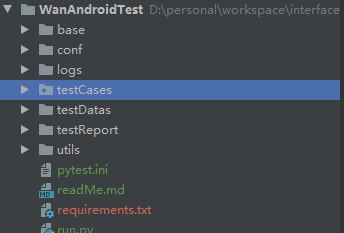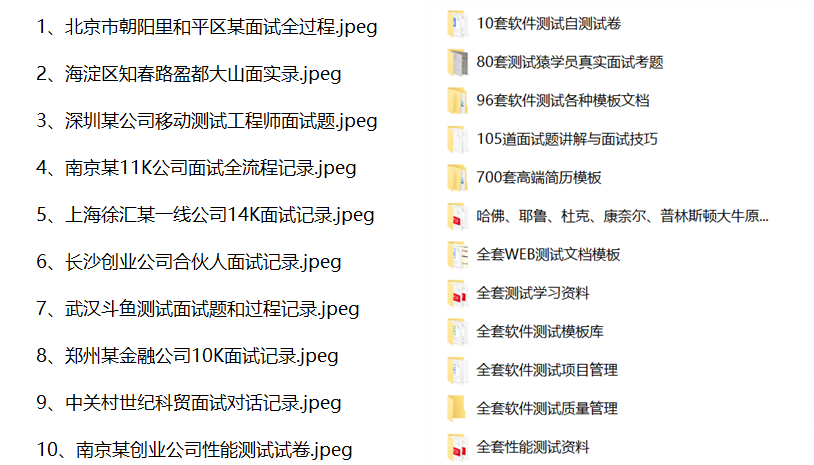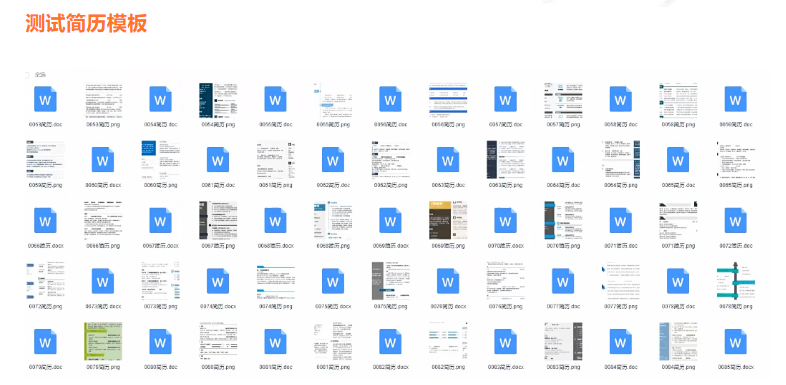1.核心库
- requests request请求
- openpyxl excel文件操作
- loggin 日志
- smtplib 发送邮件
- configparser
- unittest.mock mock服务
2.目录结构
- base
- utils
- testDatas
- conf
- testCases
- testReport
- logs
- 其他

2.1base
- base_path.py 存放绝对路径,dos命令或Jenkins执行时,防止报错
- base_requests.py 封装requests,根据method选择不同的方法执行脚本,同时处理请求异常
2.1.1 base_path.py
-
import os -
# 项目根路径 -
_root_path = os.path.split(os.path.split(os.path.realpath(__file__))[0])[0] -
# 报告路径 -
report_path = os.path.join(_root_path, 'testReport', 'report.html') -
# 日志路径 -
log_path = os.path.join(_root_path, 'logs/') -
# 配置文件路径 -
conf_path = os.path.join(_root_path, 'conf', 'auto_test.conf') -
# 测试数据路径 -
testdatas_path = os.path.join(_root_path, 'testDatas') -
# allure 相关配置 -
_result_path = os.path.join(_root_path, 'testReport', 'result') -
_allure_html_path = os.path.join(_root_path, 'testReport', 'allure_html') -
allure_command = 'allure generate {} -o {} --clean'.format(_result_path, _allure_html_path)
2.1.2 base_requests.py
-
import json -
import allure -
import urllib3 -
import requests -
import warnings -
from bs4 import BeautifulSoup -
from base.base_path import * -
from requests.adapters import HTTPAdapter -
from utils.handle_logger import logger -
from utils.handle_config import handle_config as hc -
class BaseRequests: -
def __init__(self, case, proxies=None, headers=None, cookies=None, timeout=15, max_retries=3): -
''' -
:param case: 测试用例 -
:param proxies: The result is displayed in fiddler: -
{"http": "http://127.0.0.1:8888", "https": "https://127.0.0.1:8888"} -
:param headers: 请求头 -
:param cookies: cookies -
:param timeout: 请求默认超时时间15s -
:param max_retries: 请求超时后默认重试3次 -
''' -
self.case = case -
self.proxies = proxies -
self.headers = headers -
self.cookies = cookies -
self.timeout = timeout -
self.max_retries = max_retries -
self.base_url = hc.operation_config(conf_path, 'BASEURL', 'base_url') -
def get_response(self): -
'''获取请求结果''' -
response = self._run_main() -
return response -
def _run_main(self): -
'''发送请求''' -
method = self.case['method'] -
url = self.base_url + self.case['url'] -
if self.case['parameter']: -
data = eval(self.case['parameter']) -
else: -
data = None -
s = requests.session() -
s.mount('http://', HTTPAdapter(max_retries=self.max_retries)) -
s.mount('https://', HTTPAdapter(max_retries=self.max_retries)) -
urllib3.disable_warnings() # 忽略浏览器认证(https认证)警告 -
warnings.simplefilter('ignore', ResourceWarning) # 忽略 ResourceWarning警告 -
res='' -
if method.upper() == 'POST': -
try: -
res = s.request(method='post', url=url, data=data, verify=False, proxies=self.proxies, headers=self.headers, cookies=self.cookies, timeout=self.timeout) -
except Exception as e: -
logger.error('POST请求出错,错误信息为:{0}'.format(e)) -
elif method.upper() == 'GET': -
try: -
res = s.request(method='get', url=url, params=data, verify=False,proxies=self.proxies, headers=self.headers, cookies=self.cookies, timeout=self.timeout) -
except Exception as e: -
logger.error('GET请求出错,错误信息为:{0}'.format(e)) -
else: -
raise ValueError('method方法为get和post') -
logger.info(f'请求方法:{method},请求路径:{url}, 请求参数:{data}, 请求头:{self.headers}, cookies:{self.cookies}') -
# with allure.step('接口请求信息:'): -
# allure.attach(f'请求方法:{method},请求路径:{url}, 请求参数:{data}, 请求头:{headers}') -
# 拓展:是否需要做全量契约验证?响应结果是不同类型时,如何处理响应? -
return res -
if __name__ == '__main__': -
# case = {'method': 'get', 'url': '/article/top/json', 'parameter': ''} -
case = {'method': 'post', 'url': '/user/login', 'parameter': '{"username": "xbc", "password": "123456"}'} -
response = BaseRequests(case).get_response() -
print(response.json())
2.2 utils
(只取核心部分)
- handle_excel.py
- excel的操作,框架要求,最终读取的数据需要保存列表嵌套字典的格式[{},{}]
- 其他操作 - handle_sendEmail.py
- python发送邮件使用smtp协议,接收邮件使用pop3
- 需要开启pop3服务功能,这里的password为授权码,启用服务自行百度 - handle_logger.py 日志处理
- handle_config.py
配置文件处理,这里只将域名可配置化,切换环境时改域名即可 - handle_allure.py
allure生成的报告需要调用命令行再打开,这里直接封装命令 - handle_cookies.py(略)
在git中补充,处理cookiesJar对象 - handle_mock.py(略)
在git中补充,框架未使用到,但是也封装成了方法 - param_replace(略)
将常用的参数化操作封装成类
2.2.1 handle_excel.py
-
import os -
# 项目根路径 -
_root_path = os.path.split(os.path.split(os.path.realpath(__file__))[0])[0] -
# 报告路径 -
report_path = os.path.join(_root_path, 'testReport', 'report.html') -
# 日志路径 -
log_path = os.path.join(_root_path, 'logs/') -
# 配置文件路径 -
conf_path = os.path.join(_root_path, 'conf', 'auto_test.conf') -
# 测试数据路径 -
testdatas_path = os.path.join(_root_path, 'testDatas') -
# allure 相关配置 -
_result_path = os.path.join(_root_path, 'testReport', 'result') -
_allure_html_path = os.path.join(_root_path, 'testReport', 'allure_html') -
allure_command = 'allure generate {} -o {} --clean'.format(_result_path, _allure_html_path)
2.2.2 handle_sendEmail.py
-
import smtplib -
from utils.handle_logger import logger -
from email.mime.text import MIMEText # 专门发送正文邮件 -
from email.mime.multipart import MIMEMultipart # 发送正文、附件等 -
from email.mime.application import MIMEApplication # 发送附件 -
class HandleSendEmail: -
def __init__(self, part_text, attachment_list, password, user_list, subject='interface_autoTestReport', smtp_server='smtp.163.com', from_user='hu_chunpu@163.com', filename='unit_test_report.html'): -
''' -
:param part_text: 正文 -
:param attachment_list: 附件列表 -
:param password: 邮箱服务器第三方密码 -
:param user_list: 收件人列表 -
:param subject: 主题 -
:param smtp_server: 邮箱服务器 -
:param from_user: 发件人 -
:param filename: 附件名称 -
''' -
self.subject = subject -
self.attachment_list = attachment_list -
self.password = password -
self.user_list = ';'.join(user_list) # 多个收件人 -
self.part_text = part_text -
self.smtp_server = smtp_server -
self.from_user = from_user -
self.filename = filename -
def _part(self): -
'''构建邮件内容''' -
# 1) 构造邮件集合体: -
msg = MIMEMultipart() -
msg['Subject'] = self.subject -
msg['From'] = self.from_user -
msg['To'] = self.user_list -
# 2) 构造邮件正文: -
text = MIMEText(self.part_text) -
msg.attach(text) # 把正文加到邮件体里面 -
# 3) 构造邮件附件: -
for item in self.attachment_list: -
with open(item, 'rb+') as file: -
attachment = MIMEApplication(file.read()) -
# 给附件命名: -
attachment.add_header('Content-Disposition', 'attachment', filename=item) -
msg.attach(attachment) -
# 4) 得到完整的邮件内容: -
full_text = msg.as_string() -
return full_text -
def send_email(self): -
'''发送邮件''' -
# qq邮箱必须加上SSL -
if self.smtp_server == 'smtp.qq.com': -
smtp = smtplib.SMTP_SSL(self.smtp_server) -
else: -
smtp = smtplib.SMTP(self.smtp_server) -
# 登录服务器:.login(user=email_address,password=第三方授权码) -
smtp.login(self.from_user, self.password) -
logger.info('--------邮件发送中--------') -
try: -
logger.info('--------邮件发送成功--------') -
smtp.sendmail(self.from_user, self.user_list, self._part()) -
except Exception as e: -
logger.error('发送邮件出错,错误信息为:{0}'.format(e)) -
else: -
smtp.close() # 关闭连接 -
if __name__ == '__main__': -
from base.base_path import * -
part_text = '附件为自动化测试报告,框架使用了pytest+allure' -
attachment_list = [report_path] -
password = '' -
user_list = [''] -
HandleSendEmail(part_text, attachment_list, password, user_list).send_email()
2.2.3 handle_logger.py
-
import sys -
import logging -
from time import strftime -
from base.base_path import * -
class Logger: -
def __init__(self): -
# 日志格式 -
custom_format = '%(asctime)s %(filename)s [line:%(lineno)d] %(levelname)s: %(message)s' -
# 日期格式 -
date_format = '%a, %d %b %Y %H:%M:%S' -
self._logger = logging.getLogger() # 实例化 -
self.filename = '{0}{1}.log'.format(log_path, strftime("%Y-%m-%d")) # 日志文件名 -
self.formatter = logging.Formatter(fmt=custom_format, datefmt=date_format) -
self._logger.addHandler(self._get_file_handler(self.filename)) -
self._logger.addHandler(self._get_console_handler()) -
self._logger.setLevel(logging.INFO) # 默认等级 -
def _get_file_handler(self, filename): -
'''输出到日志文件''' -
filehandler = logging.FileHandler(filename, encoding="utf-8") -
filehandler.setFormatter(self.formatter) -
return filehandler -
def _get_console_handler(self): -
'''输出到控制台''' -
console_handler = logging.StreamHandler(sys.stdout) -
console_handler.setFormatter(self.formatter) -
return console_handler -
@property -
def logger(self): -
return self._logger -
''' -
日志级别: -
critical 严重错误,会导致程序退出 -
error 可控范围内的错误 -
warning 警告信息 -
info 提示信息 -
debug 调试程序时详细输出的记录 -
''' -
# 实例 -
logger = Logger().logger -
if __name__ == '__main__': -
import datetime -
logger.info(u"{}:开始XXX操作".format(datetime.datetime.now()))
2.2.4 handle_config.py
-
import configparser -
# 配置文件类 -
class HandleConfig: -
def operation_config(self, conf_file, section, option): -
cf = configparser.ConfigParser() # 实例化 -
cf.read(conf_file) -
value = cf.get(section, option) # 定位 -
return value -
handle_config = HandleConfig() -
if __name__ == '__main__': -
from base.base_path import * -
base_url = handle_config.operation_config(conf_path, 'BASEURL', 'base_url') -
print(base_url)
2.2.5 handle_allure.py
-
import subprocess -
from base.base_path import * -
class HandleAllure(object): -
def execute_command(self): -
subprocess.call(allure_command, shell=True) -
handle_allure = HandleAllure()
2.3testDatas
excel测试用例文件,必须是.xlsx结尾,用例结构如下:

2.4conf
放置配置文件 .conf结尾
2.5 testCases
- conftest.py
- fixture功能,用例前置后置操作
- 构造测试数据
- 其他高级操作
- 注意邮件中的password和user_list需要换成自己测试的邮箱及服务密码 - test_wanAndroid.py 测试用例脚本
- 参数化: pytest.mark.parametrize('case',[{},{}])
- 接口关联:
- 将关联的参数配置成全局变量
- 在用例执行前使用全局变量替换参数
- 使用 is_run 参数指明有参数化的用例,并取出,再赋值给全局变量
- cookies:
- 和接口关联的处理方式一样处理cookies
- 步骤
- 收集用例
- 执行用例
- 断言
- 构造测试报告
- 发送邮件
2.5.1 conftest.py
-
import pytest -
from base.base_path import * -
from utils.handle_logger import logger -
from utils.handle_allure import handle_allure -
from utils.handle_sendEmail import HandleSendEmail -
''' -
1. 构造测试数据?? -
2. fixture 替代 setup,teardown -
3. 配置 pytest -
''' -
def pytest_collection_modifyitems(items): -
""" -
测试用例收集完成时,将收集到的item的name和nodeid的中文显示在控制台上 -
""" -
for item in items: -
item.name = item.name.encode("utf-8").decode("unicode_escape") -
item._nodeid = item.nodeid.encode("utf-8").decode("unicode_escape") -
# print(item.nodeid) -
@pytest.fixture(scope='session', autouse=True) -
def send_email(): -
logger.info('-----session级,执行wanAndroid测试用例-----') -
yield -
logger.info('-----session级,wanAndroid用例执行结束,发送邮件:-----') -
"""执行alllure命令 """ -
handle_allure.execute_command() -
# 发邮件 -
part_text = '附件为自动化测试报告,框架使用了pytest+allure' -
attachment_list = [report_path] -
password = '' -
user_list = [''] -
HandleSendEmail(part_text, attachment_list, password, user_list).send_email()
2.5.2 test_wanAndroid.py
-
import json -
import pytest -
import allure -
from base.base_requests import BaseRequests -
from utils.handle_logger import logger -
from utils.handle_excel import HandleExcel -
from utils.param_replace import pr -
from utils.handle_cookies import get_cookies -
handle_excel = HandleExcel() -
get_excel_data = HandleExcel().get_excel_data() -
ID = '' -
COOKIES = {} -
PAGE = '' -
class TestWanAndroid: -
@pytest.mark.parametrize('case', get_excel_data) -
def test_wanAndroid(self, case): -
global ID -
global COOKIES -
# 参数替换 -
case['url'] = pr.relevant_parameter(case['url'], '${collect_id}', str(ID)) -
if case['is_run'].lower() == 'yes': -
logger.info('------执行用例的id为:{0},用例标题为:{1}------'.format(case['case_id'], case['title'])) -
res = BaseRequests(case, cookies=COOKIES).get_response() -
res_json = res.json() -
# 获取登录后的cookies -
if case['case_id'] == 3: -
COOKIES = get_cookies.get_cookies(res) -
if case['is_depend']: -
try: -
ID = res_json['data']['id'] -
# 将使用的参数化后的数据写入excel -
handle_excel.rewrite_value('id={}'.format(ID), case['case_id'], 'depend_param') -
except Exception as e: -
logger.error(f'获取id失败,错误信息为{e}') -
ID = 0 -
# 制作 allure 报告 -
allure.dynamic.title(case['title']) -
allure.dynamic.description('<font color="red">请求URL:</font>{}<br />' -
'<font color="red">期望值:</font>{}'.format(case['url'], case['excepted'])) -
allure.dynamic.feature(case['module']) -
allure.dynamic.story(case['method']) -
result='' -
try: -
assert eval(case['excepted'])['errorCode'] == res_json['errorCode'] -
result = 'pass' -
except AssertionError as e: -
logger.error('Assert Error:{0}'.format(e)) -
result = 'fail' -
raise e -
finally: -
# 将实际结果格式化写入excel -
handle_excel.rewrite_value(json.dumps(res_json, ensure_ascii=False, indent=2, sort_keys=True), case['case_id'], 'actual') -
# 将用例执行结果写入excel -
handle_excel.rewrite_value(result, case['case_id'], 'test_result') -
def test_get_articleList(self): -
'''翻页,将page参数化''' -
global PAGE -
pass -
def test_mock_demo(self): -
'''使用mock服务模拟服务器响应''' -
pass -
if __name__ == '__main__': -
pytest.main(['-q', 'test_wanAndroid.py'])
2.6 testReport
- 存放html测试报告,安装插件pip install pytest-html
- 存放allure测试报告,插件安装pip install allure-pytest
2.7 logs
存放日志文件
2.8 其他文件
- run.py 主运行文件
- pytest.ini 配置pytest的默认行为,运行规则等
- requirements.txt 依赖环境
- 自动生成 pip freeze
- 安装 pip -r install requirements.txt
3.总结
- allure有很多有趣的操作,甚至控制用例执行行为,有兴趣可以拓展,也可以看下之前的博客
- 实现框架的难点在接口依赖
- 接口自动化应避免复杂的接口依赖,复杂的依赖只会造成测试的不可控性
- 注意频繁的操作excel会消耗性能
- 有兴趣可以将本框架集合在Jenkins中
- 本文的demo接口均采用至本站,感谢作者提供的免费接口
https://www.wanandroid.com/ - 项目git地址:…(git加密了,后续补上))
总结:
感谢每一个认真阅读我文章的人!!!
作为一位过来人也是希望大家少走一些弯路,如果你不想再体验一次学习时找不到资料,没人解答问题,坚持几天便放弃的感受的话,在这里我给大家分享一些自动化测试的学习资源,希望能给你前进的路上带来帮助。

软件测试面试文档
我们学习必然是为了找到高薪的工作,下面这些面试题是来自阿里、腾讯、字节等一线互联网大厂最新的面试资料,并且有字节大佬给出了权威的解答,刷完这一套面试资料相信大家都能找到满意的工作。


视频文档获取方式:
这份文档和视频资料,对于想从事【软件测试】的朋友来说应该是最全面最完整的备战仓库,这个仓库也陪伴我走过了最艰难的路程,希望也能帮助到你!以上均可以分享,点下方小卡片即可自行领取。

























 1185
1185

 被折叠的 条评论
为什么被折叠?
被折叠的 条评论
为什么被折叠?








